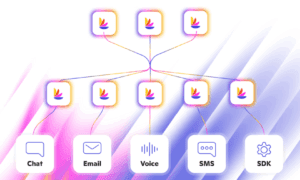In the past, customers had little to no direct interaction with brands. Customers purchased off word-of-mouth referrals from a friend or family member. The customer would then walk into a brick-and-mortar store to make a purchase and move on.
Today, things are different. Customers are constantly bombarded online with various options of brands to purchase from. This makes customers picky with which brands to patronize and why. Different factors usually affect a buying decision; however, 94% of customers say a good customer service experience will make them repurchase from a brand.
This staggering figure is why brands constantly change how they cater to their customers. As a result, customer service has evolved so much over the past years.
For example, consider how Salesforce dominated the customer relationship management (CRM) scene for several years. However, today, brands are exploring niche Salesforce alternatives that can provide more tailored CRM solutions to improve their customer service.
This post will explore the evolution of customer service and shed light on what has changed and what is to come.
Customer service in the past
In the 19th century, if a customer had an issue with a company, the options were to call toll-free numbers and call centers. This process was incredibly daunting, with customers placed on hold by customer care representatives for hours, still not getting proper attention. Several customers would be placed in long queues on call lines, only to be advised to call back at a different time.
Needless to say, it wasn’t fun. A typical customer care strategy was often hinged on what was easiest and cheapest for companies. Also, there were no emails, chats or social media platforms where customers could voice their displeasure about a company, so companies didn’t rush to rectify bad situations on time.
Say hello to the internet.
The 90s and 2000s brought the internet, completely revolutionizing how companies did business and customers interacted with brands. Customers went from only being able to contact businesses during work hours (9-5) to having 24/7 access to customer care representatives.
With the invention of social media platforms like Facebook and Twitter, customers became more vocal about their experiences with brands. Public reviews were rife, and several brands struggled with retention. As a result, they had to strategize on managing these types of public interactions with their customers while providing a good experience.
This led to an increase in the customer service avenues. From emails to live chats and even sending direct messages on social media, brands continue to utilize all platforms to serve their customers.
What customers expect today
Customers want timely and high-quality service that is always available. They are not okay with waiting for days before getting a resolution, which is why 61% of them switch to competitors when unhappy. They also want to be served on their preferred channels, which could differ.
For example, customer A could prefer speaking with a customer care representative via live chatbots, while another could prefer reaching out on Twitter. Diverting each customer into another channel could frustrate them and cause them to look elsewhere.
Customers expect companies to always accommodate their needs, and if this isn’t done, they will look for other options while publicly sharing their displeasure. Customer patience is extremely limited, so brands have to take customer service very seriously.
Let’s share more insight into what customers expect from brands regarding customer service.
Self-service
Customers often prefer to solve their issues without engaging a customer care representative. This study shows that 67% of customers would choose a self-service option over speaking with a company representative. The same study also revealed that 91% of customers would happily use a company’s knowledge base if it solved their issues.
Many customers expect companies to have a self-service option backed by an extensive knowledge base. This is very helpful when customers need a quick answer to a question and don’t want to interact with a representative.
However, in cases where the issues are complex and the customer can’t find answers with self-service, they expect help from agents with knowledge about the issue and can offer help without transferring them to someone else.
Companies can stay ahead of this by merging all their knowledge base and self-help material into one system and performing regular updates. This way, customers are not using outdated information, and agents have all the tools they need to help customers.
Omnichannel support
Customer service channels range from phone calls to email, live chat, social media and self-service. Omnichannel support means offering customers support via these different channels and enabling them to choose their preferred ones and switch if they want to. This aims to make customer service as easy as possible and let customers reach out via the platforms they feel most at ease on.
For example, if a customer wants to resolve an issue without contacting a company representative, the self-service option should be available and helpful. On the other hand, if a customer reaches out on Twitter for help, an agent should be available to cater to the customer immediately. Omnichannel support is all about prioritizing your customers and meeting them on their terms.
Companies benefit from this, too, as research has shown increased customer loyalty and retention for companies that prioritize omnichannel support.
Company representatives should be in the loop.
Customers hate repeating themselves and get frustrated when they get transferred to different agents and channels and are repeatedly asked the same questions. A bad CRM strategy and internal dysfunction could cause this issue. Companies must equip their representatives with the tools they need to be aware of customer issues, especially when they have been transferred a few times.
For example, imagine a customer stuck in a situation without access to their account information. If they had provided this information sometime in the past, they would expect the representative to make the situation easier and offer practical help.
Customer care agents should be proactive.
Customers expect agents to go beyond simply fixing an issue and be proactive enough to help them avoid future issues. In this situation, agents are trained to listen to customers, pick up on clues and tailor their answers to match. This strategy reduced repeat calls by 40%, according to research done by Harvard Business School.
For example, a customer calls to complain about having trouble logging into their account. The company agent could say something like, “I noticed you’ve used the ‘forget password’ feature thrice this month already. Would you like me to recommend a few ways to keep your new password safe so you don’t forget it again?”
This scenario shows that the agent cares about the customer and is not just reverting the scripts they were trained with. The customer will surely appreciate the proactiveness and possibly stick with the company. Gone are the days when customers didn’t mind communicating with automated voices. They want the human touch when struggling with your service or product.
What should customers expect in future?
Customer service changes rapidly. In future, customers should expect total automation of service channels. For example, several companies have already started integrating AI chatbots into their customer service channels. This automation reduces the workload on agents by only granting customers access to them for serious issues.
These chatbots are fed with vital information or knowledge base related to customers’ most common questions. They then revert with answers which could be in the form of a link, individual messages, an image, etc. Companies will continue leveraging AI in customer care. With the technology still in developmental stages, several companies are already experimenting to stay ahead of the curve.
Final Thoughts: The evolution of customer service
Customer service has taken major leaps these past decades and will only improve. With the right CRM tools, adequate training and humanity, brands can fully transform their customer service strategy and keep their customers happy.
The past years have shown that a high-quality product or service is important, but you get consistent revenue when you have a strong customer support system. In future, this could mean leaning into automation of existing channels and leveraging AI.
Bottom line, we know customer service will look very different 10 or 20 years from now, and we are eager to see where the road leads.



































